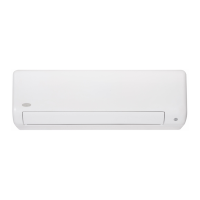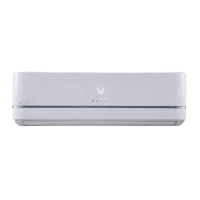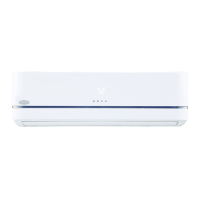Do you have a question about the Carrier 40MAHBQ12XA3 and is the answer not in the manual?
Provides necessary information to service, repair, and maintain the 40MAHB heat pumps.
Explains the structure and meaning of model and serial numbers for unit identification.
Details electrical, indoor unit, and piping specifications across different unit sizes.
Lists compatible outdoor units for various indoor unit models.
Provides physical dimensions (height, width, depth) for indoor units.
Specifies required clearances around the indoor unit for proper operation.
Lists FLA, HP, MCA, and wire sizing guidelines for indoor fan motors.
Details wire sizing, type, and recommended connection methods for power and communication.
Illustrates wiring connections between indoor and outdoor units for various voltage types.
Details the internal wiring connections within the indoor unit.
Visual representation of the refrigerant flow during cooling and heating operations.
Important note regarding the insulation of refrigerant lines.
Provides technical data for the high wall unit fan motors, including material, size, and electrical ratings.
Outlines procedures for evacuating the system using vacuum pumps.
Describes the deep vacuum method for system evacuation.
Details the alternate triple evacuation method for system evacuation.
Describes protection functions like fan speed out of control and inverter module protection.
Explains indoor fan running rules and evaporator temperature protection in cooling mode.
Details indoor fan running rules and anti-cold air function in heating mode.
Describes the operation of the defrosting mode.
Explains fan speed and low room temperature protection in drying mode.
Allows manual control of operation modes like Forced AUTO and Forced COOLING.
Explains how the system detects and indicates refrigerant leaks.
Details how to access and interpret system status information via the remote controller.
Emphasizes capacitor discharge safety before performing troubleshooting.
Lists and describes error codes displayed on the indoor unit for diagnostics.
Provides troubleshooting steps for EEPROM parameter errors.
Outlines troubleshooting for indoor/outdoor unit communication failures.
Details troubleshooting for zero crossing detection errors.
Provides steps to resolve fan speed control issues.
Troubleshooting for temperature sensor circuit issues.
Steps to diagnose and resolve refrigerant leakage errors.
Troubleshooting for overload current protection issues.
Steps to diagnose IPM or IGBT over-current protection faults.
Troubleshooting for over or under voltage protection errors.
Steps for diagnosing compressor high temperature protection.
Troubleshooting for inverter compressor drive errors.
Procedure to measure the resistance of temperature sensors using a tester.
Table of resistance values for sensors T1, T2, T3, T4 at various temperatures.
Table of resistance values for sensor T5 at various temperatures.
Procedure to check IPM continuity using a digital tester.
Step-by-step guide to remove the front panel of the indoor unit.
Instructions for safely accessing and removing electrical components.
Procedure to remove the evaporator unit.
Steps to remove the fan motor and fan assembly.
| Brand | Carrier |
|---|---|
| Model | 40MAHBQ12XA3 |
| Category | Air Conditioner |
| Language | English |












